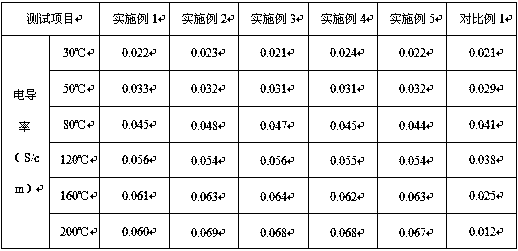A heat-resistant proton exchange membrane for fuel cell and a preparation method thereof
A proton exchange membrane and fuel cell technology, applied in fuel cells, circuits, electrical components, etc., can solve the problems of phosphoric acid loss, conductivity drop, etc.
- Summary
- Abstract
- Description
- Claims
- Application Information
AI Technical Summary
Problems solved by technology
Method used
Image
Examples
Embodiment 1
[0030] a. Dissolve organic substance A in an organic solvent, add insoluble inorganic salt B and disperse, adjust the pH to acidic and completely dissolve inorganic salt B, add additives, raise the temperature to 270°C for 4 hours, add oxidant and stir after the reaction is completed, and obtain A solution of modified organic-metal ion ligands, in which the metal ions are uniformly distributed inside the organic phase;
[0031] b. Centrifuge the solution prepared in step a, wash the centrifuge repeatedly with deionized water, then add it to an aqueous phosphoric acid solution with a mass concentration of 46%, heat at 190°C to completely evaporate the solvent, and obtain an improved phosphoric acid-doped solution. Colloidal solid material with organic phase loaded with inorganic salt;
[0032] c. The colloidal solid material obtained in step b is formed by pressing, the surface is treated with acid resistance, and dried and solidified in vacuum to obtain a heat-resistant fuel c...
Embodiment 2
[0036] a. Dissolve organic substance A in an organic solvent, add insoluble inorganic salt B and disperse, adjust the pH to acidic and completely dissolve inorganic salt B, add additives, raise the temperature to 270°C for 4 hours, add oxidant and stir after the reaction is completed, and obtain A solution of modified organic-metal ion ligands, in which the metal ions are uniformly distributed inside the organic phase;
[0037] b. Centrifuge the solution prepared in step a, wash the centrifuge repeatedly with deionized water, then add it to an aqueous phosphoric acid solution with a mass concentration of 40%, and heat at 170°C to completely evaporate the solvent to obtain an improved phosphoric acid-doped solution. Colloidal solid material with organic phase loaded with inorganic salt;
[0038] c. The colloidal solid material obtained in step b is formed by pressing, the surface is acid-resistant treated, and vacuum-dried and solidified to obtain a heat-resistant fuel cell pro...
Embodiment 3
[0042] a. Dissolve organic substance A in an organic solvent, add insoluble inorganic salt B and disperse, adjust the pH to acidic and completely dissolve inorganic salt B, add additives, raise the temperature to 270°C for 4 hours, add oxidant and stir after the reaction is completed, and obtain A solution of modified organic-metal ion ligands, in which the metal ions are uniformly distributed inside the organic phase;
[0043] b. Centrifuge the solution prepared in step a, wash the centrifuge repeatedly with deionized water, then add it to an aqueous phosphoric acid solution with a mass concentration of 50%, and heat at 200°C to completely evaporate the solvent to obtain an improved phosphoric acid-doped solution. Colloidal solid material with organic phase loaded with inorganic salt;
[0044] c. The colloidal solid material obtained in step b is formed by pressing, the surface is acid-resistant treated, and vacuum-dried and solidified to obtain a heat-resistant fuel cell pro...
PUM
 Login to View More
Login to View More Abstract
Description
Claims
Application Information
 Login to View More
Login to View More - R&D
- Intellectual Property
- Life Sciences
- Materials
- Tech Scout
- Unparalleled Data Quality
- Higher Quality Content
- 60% Fewer Hallucinations
Browse by: Latest US Patents, China's latest patents, Technical Efficacy Thesaurus, Application Domain, Technology Topic, Popular Technical Reports.
© 2025 PatSnap. All rights reserved.Legal|Privacy policy|Modern Slavery Act Transparency Statement|Sitemap|About US| Contact US: help@patsnap.com

